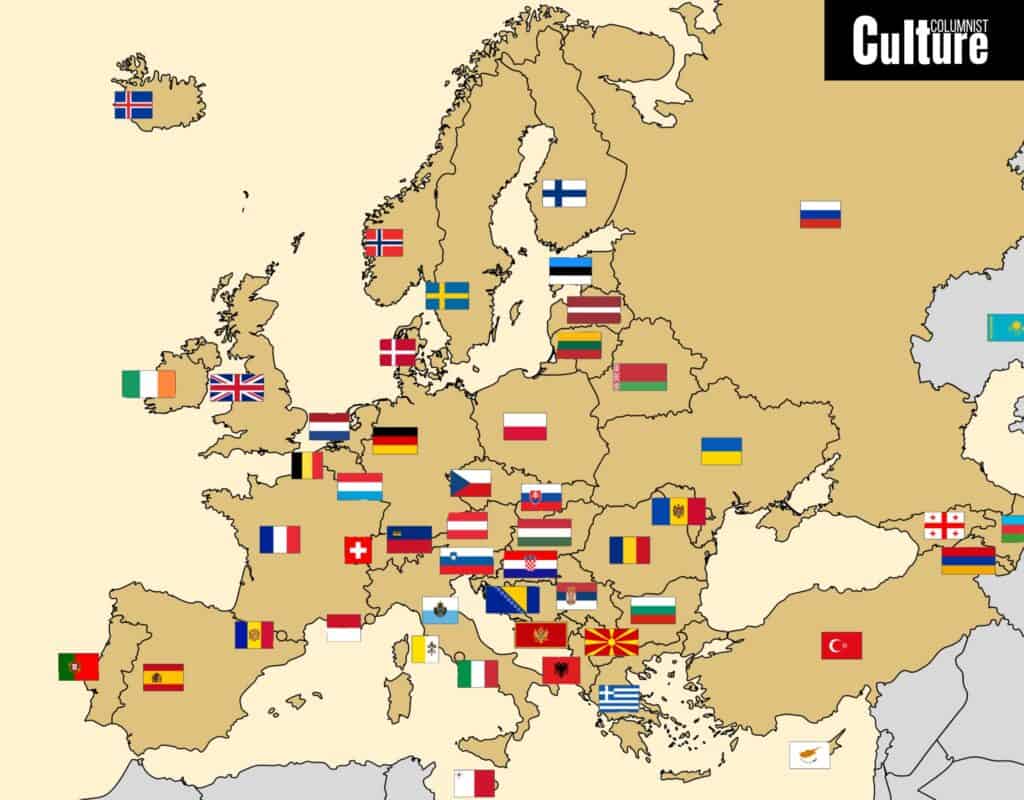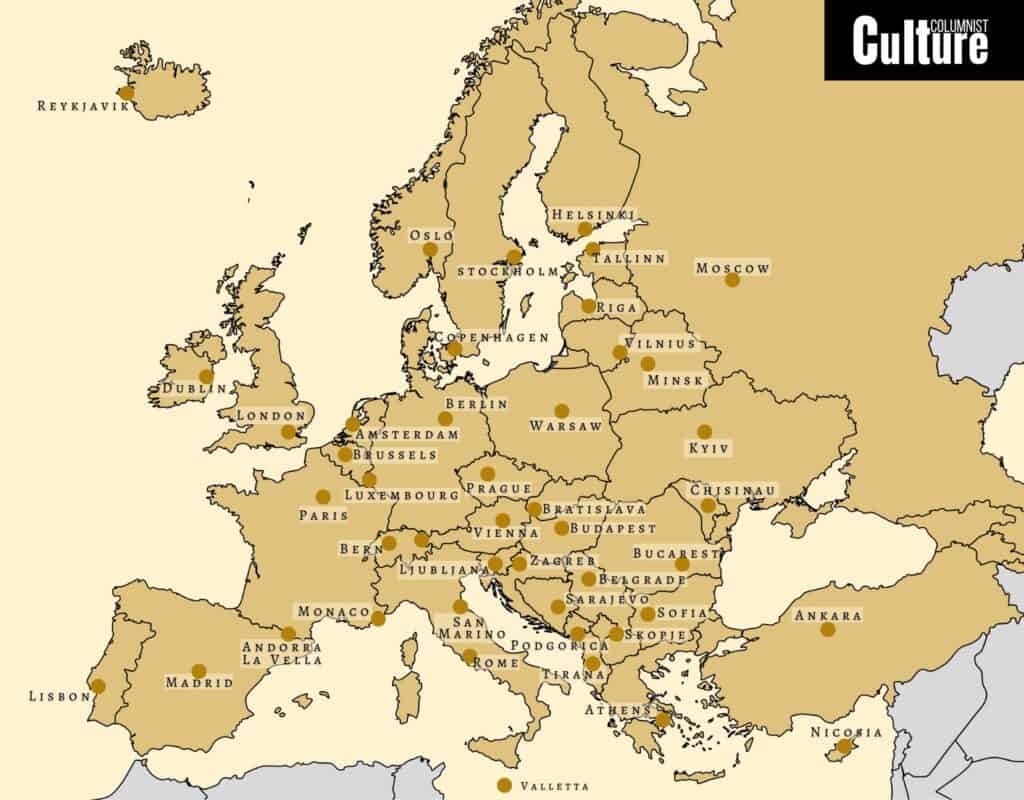The Ultimate Travel Guide To Visiting Europe
Europe is a dream destination for many travelers, and it’s not hard to see why. Imagine sipping your morning espresso in Italy, exploring the ancient temples of Greece, or taking in the breathtaking views in the Scottish Highlands.
Vacations in Europe are packed with history, culture, impressive landscapes, and delicious food, with something to interest every type of traveler. However, the journey from dreaming about a European adventure to actually getting there can be daunting.
The complexity of planning, organizing, and booking all the elements of your trip can be challenging, particularly if you’ve never been before or aren’t used to traveling. This travel guide is designed to help you start planning everything you need for a trip to Europe.
From the official prerequisites you’ll need and the diverse range of destination countries, cities and places you have to choose from to the most frequently asked questions about traveling to Europe, this guide is your first step towards making your dreams a reality.
Pro Tip: Bookmark In Your Browser To Keep This Travel Guide At Hand
Table of Contents
- What do you need to travel to Europe?
- What is the Schengen zone?
- European Destinations
- Click to view a full list of countries in Europe
- What is the most popular European destination in 2023?
- Which country in Europe should I visit first?
- What are the capital cities in Europe?
- Click to view a full list of the capital cities in Europe
- Which is the most beautiful European city?
- Which European city has the most to do?
- What is the best time to visit Europe?
- How safe is it to travel in Europe?
What do you need to travel to Europe?
When traveling to Europe, the requirements can vary depending on your nationality, the purpose of your trip, and the specific countries you plan to visit. Here are the key requirements for EU and non-EU nationals, including U.S. passport holders:
- A valid passport with at least six months of validity beyond their planned departure date from the Schengen Area. EU citizens traveling within the Schengen Area are typically required to have a valid national ID card or passport.
- A Schengen or national visa for the countries you’re visiting may be required, depending on your nationality. EU citizens do not need a Schengen or national visa to travel in Europe.
- Supporting documents, such as travel itineraries, proof of accommodation, sufficient funds for your stay, and travel insurance with medical coverage, when traveling to Europe.
- No Covid-19 testing or vaccination is required to enter Europe. However, you should double check for any specific health and safety requirements, including testing and vaccination, for each country you travel to.
What are the new rules for traveling to Europe?
Starting in 2025, people from over 60 previously visa-exempt countries wishing to travel to Europe, including U.S. passport holders, will need to apply for authorization before their visit through the European Travel Information and Authorization System (ETIAS) for short stays of up to 90 days.
The new travel authorization system allows you to enter 30 European countries for a short stay, including: Austria, Belgium, Bulgaria, Croatia, Cyprus, Czech Republic, Denmark, Estonia, Finland, France, Germany, Greece, Hungary, Iceland, Italy, Latvia, Liechtenstein, Lithuania, Luxembourg, Malta, Netherlands, Norway, Poland, Portugal, Romania, Slovakia, Slovenia, Spain, Sweden and Switzerland.
Do I need Etias in 2024?
You do not need ETIAS in 2024 to travel to Europe. The new system will be introduced in 2025 and no applications will be accepted until that point. It is important to note that only visa-exempt travellers will be required to have ETIAS to travel to Europe. You can find out who is required to have ETIAS on the official EU website.
What is the 90 day rule in Europe?
The 90 day rule in Europe means your total stay in the Schengen area must be no more than 90 days in every 180 days, no matter how many countries you visit. You will need a valid passport and a Schengen visa, depending on your nationality. The 90 day period starts from the date you enter the first Schengen country.
What is the Schengen zone?
The Schengen Zone is a group of 27 European countries, covering nearly all of mainland Europe, that allows people from certain countries – including the United States, to move across their borders without going through border controls. “Schengen” is named after a village in Luxembourg where the agreement was signed.
The 27 Schengen countries are Austria, Belgium, the Czech Republic, Croatia, Denmark, Estonia, Finland, France, Germany, Greece, Hungary, Iceland, Italy, Latvia, Liechtenstein, Lithuania, Luxembourg, Malta, the Netherlands, Norway, Poland, Portugal, Slovakia, Slovenia, Spain, Sweden, and Switzerland.
- Countries in the European Union but are not in the Schengen Zone include Bulgaria, Cyprus, Ireland and Romania
- Countries that are not in the EU but are part of the Schengen Agreement include Iceland, Liechtenstein, Norway and Switzerland.
- European countries that are not in the EU or the Schengen Zone include: Albania, Andorra, Azerbaijan, Belarus, Bosnia and Herzegovina, Kosovo, Moldova, Monaco, Montenegro, North Macedonia, Russia, San Marino, Serbia, Turkey, Ukraine, and the United Kingdom.
- Meanwhile, the microstates of San Marino, Monaco, and Vatican City are also not official members of the Schengen Zone. However, these three are considered ‘de facto’ inside the area — and, therefore, do not impose border controls.

What happens if you want to stay in Europe for more than 90 days?
You could be fined, deported or banned from the Schengen Area for several years if you stay longer than 90 days on a Schengen visa or visa-free stay in Europe. To travel for an extended period, one option is to leave the Schengen Zone before your 90-day limit expires and then return after some time has passed.
You can re-enter the Schengen Zone after the 180-day period from your initial entry date has elapsed. Otherwise, you will need to apply for a national visa for the specific country you want to stay in. If you are having trouble counting your 90-days correctly, try using the Schengen Calculator to make sure your stay is within the legal limit.
Can I travel anywhere in Europe?
Non-EU nationals can visit Europe’s Schengen Area for up to 90 days for tourism or business, with or without a Schengen visa, depending on your nationality. If you’re traveling to a non-Schengen European country, you must apply for a national visa, depending on the country’s nationality requirements.
EU nationals have the right to travel freely in the 27 EU member countries, as well as in Iceland, Liechtenstein, Norway and Switzerland, carrying either a valid passport or a national identity card (ID).
Can I leave the Schengen zone and come back?
Yes, it is possible to leave the Schengen Zone and come back after a temporary absence. A Schengen visa or visa-free stay allows for multiple entries within the 180-day validity period. However, leaving and returning does not reset this 90-day clock; you will have to wait until the 180-day period is up to reapply.
Should you carry your passport with you in Europe?
In Europe, it’s recommended to carry a photocopy of your passport and visa with you at all times so you can prove your identity and citizenship if needed. Keep your actual passport in a secure location, such as a hotel safe or hidden in your luggage, to reduce the risk of losing your passport or having it stolen.
However, it is always best to check the specific requirements for each country you plan to visit during your journey if you have any doubts.
Does Europe have a tourism board?
The European Travel Commission (ETC) represents Europe’s travel sector as a whole. The ETC is a collection of 35 individual national tourism organizations from European countries rather than a single “European tourist board” and is responsible for promoting Europe as a tourist destination.
Other key tourism organizations in Europe include the European Union National Institutes for Culture (EUNIC), which plays a role in promoting European culture and heritage, followed by each country’s national tourism board, which is responsible for promoting tourism to that specific country. These boards often collaborate with the ETC and other international organizations to boost tourism.
European Destinations
There are 50 countries in Europe including transcontinental countries (straddling both Europe and Asia), including Russia, Armenia, Azerbaijan, Georgia, and Turkey; partially recognized states, including Kosovo; and microstates like Monaco, San Marino, Liechtenstein, Andorra, and Vatican City.
Russia is the largest and most populated country in Europe, covering a total of around 37% of the continent, while Vatican City is the smallest and least populated official country in Europe, occupying only a tiny territory in the center of Rome. While Russia and Ukraine are considered European countries, it is not advisable to travel there at this time.

Click to view a full list of countries in Europe
- Albania
- Andorra
- Armenia
- Austria
- Azerbaijan
- Belarus
- Belgium
- Bosnia and Herzegovina
- Bulgaria
- Croatia
- Cyprus
- Czechia
- Denmark
- Estonia
- Finland
- France
- Georgia
- Germany
- Greece
- Hungary
- Iceland
- Ireland
- Italy
- Kosovo
- Latvia
- Liechtenstein
- Lithuania
- Luxembourg
- Malta
- Moldova
- Monaco
- Montenegro
- Netherlands
- North Macedonia
- Norway
- Poland
- Portugal
- Romania
- Russia
- San Marino
- Serbia
- Slovakia
- Slovenia
- Spain
- Sweden
- Switzerland
- Turkey
- Ukraine
- United Kingdom (UK)
- Vatican City (Holy See)
What is the most popular European destination in 2023?
France was the most popular country in Europe in 2023, with more than 72 million visits, according to a study published in November 2023. Spain was the second most popular destination with 70 million visits, and Turkey was the third most popular destination in Europe with 45 million visits.
All three countries generally enjoy a Mediterranean climate with warm, sunny summers and mild winters, making them attractive year-round destinations.
Which country in Europe should I visit first?
France is recommended for first-time travellers to Europe because it has some of the world’s most famous landmarks, like the Eiffel Tower, Notre-Dame Cathedral, and the Louvre Museum; rich cultural heritage; world-renowned cuisine; and a variety of landscapes, from beaches in the Riviera to ski resorts in the Alps.
The best countries in Europe to visit are the ones that spark your interest the most, whether it’s exploring historical sites, enjoying nature, having great food, or shopping. Each European country has its own unique culture, language and attractions, so there’s no wrong choice.
Western European countries tend to be more expensive like Ireland, Switzerland and Luxembourg, while Eastern European countries are typically more budget-friendly like Bulgaria, Romania and Albania.
Northern European countries like Norway and Iceland are great in the summer for their pleasant temperatures and long days, while southern European countries like Greece, Italy and Spain are ideal for warm winter escapes.
What are the capital cities in Europe?
There are 50 capital cities in Europe. Moscow, in Russia, is the biggest capital city on the continent at 2,511 km² (970 square miles) with a population of almost 12 million. Vatican City is the smallest capital in Europe, at 0.49 km² (30 square miles) and a population of 764.
Although the city of Istanbul in Turkey is not a capital city, it is the largest city in Europe by population, with 15.8 million people. It lies between two continents, Europe and Asia, and is therefore not fully located on the continent of Europe.
While the majority of European countries only have one official capital city, three countries in Europe are considered to have two capital cities.
These are Georgia with the cities of Tbilisi and Kutaisi; Montenegro with the cities of Podgorica and Cetinje; and the Netherlands with the cities of Amsterdam and The Hague.
While Europe is made up of many sovereign countries, each with its own capital, people often refer to Brussels, Belgium, as the “capital of Europe.” This is because it is one of the most important international trade and business centers in Europe and because it is the location of the headquarters of the European Union.
Click to view a full list of the capital cities in Europe
- Tirana — Albania
- Andorra la Vella — Andorra
- Yerevan — Armenia
- Vienna — Austria
- Baku — Azerbaijan
- Minsk — Belarus
- Brussels — Belgium
- Sarajevo — Bosnia and Herzegovina
- Sofia — Bulgaria
- Zagreb — Croatia
- Nicosia — Cyprus
- Prague — Czechia
- Copenhagen — Denmark
- Tallinn — Estonia
- Helsinki — Finland
- Paris — France
- Tbilisi / Kutaisi — Georgia
- Berlin — Germany
- Athens — Greece
- Budapest — Hungary
- Reykjavik — Iceland
- Dublin — Ireland
- Rome — Italy
- Pristina — Kosovo
- Riga — Latvia
- Vaduz — Liechtenstein
- Vilnius — Lithuania
- Luxembourg City — Luxembourg
- Valletta — Malta
- Chisinau — Moldova
- Monaco — Monaco
- Podgorica / Cetinje — Montenegro
- Amsterdam / The Hague — the Netherlands
- Skopje — North Macedonia
- Oslo — Norway
- Warsaw — Poland
- Lisbon — Portugal
- Bucharest — Romania
- Moscow — Russia
- San Marino — San Marino
- Belgrade — Serbia
- Bratislava — Slovakia
- Ljubljana — Slovenia
- Madrid — Spain
- Stockholm — Sweden
- Bern — Switzerland
- Ankara — Turkey
- Kyiv — Ukraine
- London — United Kingdom (UK)
- Vatican City — Vatican City (Holy See)

Which is the most beautiful European city?
Paris is considered the most beautiful city in Europe; dubbed the ‘City of Love’ or the ‘City of Light’, it’s decorated with Haussmann style architecture, ornate stone facade buildings, boulevards lined with trees illuminated by Parisian street lamps and iconic landmarks that contribute to a picturesque skyline.
The Seine River, which winds its way through Paris, is dotted with historic bridges and riverbanks (a UNESCO World Heritage Site). The city is also home to numerous well-maintained parks and manicured gardens, such as the Luxembourg Gardens, Tuileries Garden, and Parc des Buttes-Chaumont.
However, beauty is subjective, and there is a diverse range of beautiful cities in Europe worth visiting, each with its own unique charm and type of visual appeal. For example, Venice, Italy, is known for its intricate network of canals and Renaissance buildings that give off a romantic atmosphere.
Which European city has the most to do?
London is Europe’s most entertaining city, with the most to do for tourists and visitors. Thanks to iconic landmarks like the Houses of Parliament, Buckingham Palace, and the Tower of London, and attractions like the British Museum, National Gallery, and the West End theatre district, London is a prime tourist destination.
London has 192 museums, including 11 national museums, over 1,500 art galleries, 39 Greater London zoos and wildlife parks, 30 theme parks and funfairs, 39 theatres in the West End alone, 25 castles and palaces, 3,000 parks, 3,500 pubs and well over 50 famous landmarks to see around the city.
Paris and Rome are also very entertaining cities to explore but which city you choose mostly depends on what type of activity or attractions you’re interested in. For example, if you prefer to spend most of your time outdoors, a city with little rainfall will allow you more freedom to enjoy the open air.
What is the best time to visit Europe?
Overall, late March to early June and September to November are the best times to visit Europe, as you’ll avoid the busier summer period and see your money go further. Northern Europe is generally warm and dry between May and September, while farther south, temperatures can reach 36°C (96°F) between July and August.
Where is the best climate in Europe?
The best climate in Europe is typically found in southern Europe, where you’ll find Mediterranean countries with hot, dry summers and mild winters like Spain, southern France, Italy, and Greece. These countries offer the best weather in Europe for those who prefer warm, sunny weather and minimal rainfall.
However, if you prefer cooler summer temperatures and don’t mind some rainfall, the British Isles and Scandinavian countries like Finland, Norway or Denmark might be more suitable. The best snowy weather in Europe includes the Swiss, Italian and French Alps, as well as some eastern European countries, including Bulgaria, Latvia and Lithuania.
Which countries in Europe are not too hot in July?
The United Kingdom, Ireland, Norway, Sweden, Denmark, Finland, The Netherlands, Belgium, Germany, Poland, Estonia, Latvia, Lithuania, Switzerland and Austria are European countries that typically experience milder temperatures in the summer months compared to the hot Mediterranean climate.
Temperatures in these countries during the summer are typically warm, with moderate temperatures in the mid-20° Celcius (mid 70° Fahrenheit). They tend to be more cloudy than the southern parts of Europe, offering respite from the direct heat of the sun, which is further cooled by a light breeze, making them suitable for travelers who prefer a cooler climate.
Europe Month Guide: Weather and Things to Do In Europe

Europe in January is deep in winter so expect short days and long nights, with cold and snowy conditions in the north and east. Western and southern Europe, like Spain and Italy, experience milder weather. It’s low season for most of Europe, except for ski resorts in the Alps and Pyrenees, which are in peak season.
Things to do in Europe in January include celebrating Hogmanay (New Year’s) in Edinburgh, Scotland, with a massive street party and fireworks; La Tamborrada in San Sebastián, Spain, with parades and drumming to commemorate the city’s resistance against Napoleon’s troops; and the International Ice Sculpture Festival in Bruges, Belgium.
February in Europe sees cold weather, especially in Northern and Eastern Europe, with the potential for heavy snow and freezing temperatures. Southern Europe is slightly warmer but not yet spring-like. Low season continues in most parts, leading to fewer tourists and lower prices, except in ski destinations.
Things to do in Europe in February include the Venice Carnival in Italy, with elaborate costumes and masquerade parades; the Battle of the Oranges in Ivrea, Italy, a historic food fight where participants throw oranges at each other as part of the Carnivale di Ivrea celebration; and the Lemon Festival in Menton, France.
March brings milder weather to southern and western Europe, while the north and east remain cooler. The weather is unpredictable, ranging from sunny to rainy, especially in Western Europe. It’s generally a low season in most places as the ski resorts start to close, making it a good time to explore without the crowds.
Things to do in Europe in March include celebrating St. Patrick’s Day in Dublin, Ireland, with parades and music; visiting the Keukenhof Gardens in Amsterdam, Holland, to see the cherry blossoms in bloom; and visiting the Las Fallas festival in Valencia, Spain, with parades of giant paper structures called ninots.
Spring arrives in Europe by April, with warmer temperatures and longer days across the continent. Northern Europe begins to thaw while Southern Europe sees pleasant weather, ideal for sightseeing. It’s a good time to avoid summer crowds but Easter can be busy as most schools close and families go on holiday.
Things to do in Europe in April include celebrating Andalusian culture at the Sevilla Fair with flamenco dancing and parades in Seville; King’s Day in the Netherlands, an orange-filled celebration for the king’s birthday; and Sant Jordi Day in Barcelona, Spain, exchanging roses and books in honor of St. George.
May brings warm weather throughout most of Europe. It’s an excellent time for outdoor activities, with flowers blooming and green landscapes. Southern Europe starts to warm up, ideal for beach trips, while Northern Europe enjoys comfortable temperatures. It offers a balance of good weather and moderate tourist numbers.
Things to do in Europe in May include the Cannes Film Festival in France; the Chelsea Flower Show in London, UK; the Prague Spring International Classical Music Festival in the Czech Republic; the Monaco Formula One Grand Prix; and the “Caves Ouvertes” in the Vaud region of Switzerland, where you can taste Swiss wines.
June brings summer weather to Europe, with warm temperatures and longer days. Northern Europe has pleasant weather and midnight sun phenomena, while southern Europe starts to heat up significantly. It’s the beginning of peak tourist season, especially in Mediterranean countries, with higher prices and large crowds.
Things to do in Europe in June include the Midsummer Festival in Sweden, celebrating the longest day of the year; the Running of the Bulls in Pamplona, Spain; the Royal Ascot in England, a prestigious horse racing event where attendees showcase their fashion sense; and the famous Glastonbury music festival in Scotland.
July is peak summer in Europe, with hot and sunny weather, especially in southern Europe. Northern and Central Europe have warm sunshine with cool breezes. It’s peak tourist season, with busy beaches and attractions. Popular festivals and events occur throughout the continent, making it a vibrant but busy time to visit.
Things to do in Europe in July include the Tour de France bicycle race; Bastille Day in Paris, with fireworks and concerts; the Tomatina Festival in Buñol, Spain, the world’s largest tomato fight; Festa de São João in Porto, Portugal; and the Athens Epidaurus Festival in Greece, with classical theatre performances.
August sees hot temperatures, particularly in the Mediterranean. It’s the traditional holiday month for many Europeans, leading to crowded tourist spots and high prices. Many cities in southern Europe can be excessively hot, leading some to close for summer break, while northern Europe typically stays warm but cloudy.
Things to do in Europe in August include the Edinburgh Festival Fringe in Scotland, a month-long celebration of arts and culture; the Fleadh Cheoil Na hEireann, an open-air Irish Music Festival in Ireland; and the Sziget Festival in Budapest, Hungary, one of the largest music and cultural festivals in Europe.
September in Europe has pleasant weather with fewer crowds. It’s a good time to visit both Northern and Southern Europe, with mild temperatures and lower humidity. The Mediterranean coasts are still warm enough for beach holidays, making them ideal for those seeking a balance of good weather and fewer tourists.
Things to do in Europe in September include Oktoberfest in Munich, Germany, the world’s largest beer festival; Grape Harvest in the Douro Valley, Portugal; the St. Giles’ Fair in Oxford, UK, with funfair rides and stalls dating back to the 17th century; and the Braemar Gathering, part of the Highland Games circuit.
October brings cooler temperatures and changing foliage, especially in Central and Northern Europe, offering picturesque landscapes. Southern Europe stays mild, but beach holidays are less popular. It’s low season in most parts, with fewer crowds and lower prices, except for during autumn school breaks and large events.
Things to do in Europe in October include the International White Truffle Fair in Alba, Italy; the Chocolate Festival in Perugia, Italy; the Celtic festival of Samhain, the origin of Halloween in Ireland; and the Nuit Blanche Festival, which illuminates the city of Paris with special light installations for one night.
November sees colder, shorter days as winter approaches. Southern Europe remains relatively mild, while Northern and Eastern Europe start to experience winter chill. It’s low season with minimal tourist crowds, making it a good time for city breaks, with some Christmas markets opening by late November.
Things to do in Europe in November include Guy Fawks Night in the UK, with elaborate fireworks displays over the skies of London; the Iceland Airwaves Music Festival, which takes place across Reykjavík; and Beaujolais Nouveau Day in France, a time to celebrate new French wine, fresh from the year’s harvest.
December in Europe is cold and dark in the north, with the potential for snow, while in southern Europe it’s milder. Winter resorts start to open in Alpine regions and cities become festive with holiday decorations and Christmas markets, particularly in Central Europe, making it a magical, though busy, time to visit.
Things to do in Europe in December include visiting the Christmas markets in cities like Cologne, Nuremberg, and Munich; seeing the Northern Lights in the wilderness of Lapland, Finland; and seeing the szopka festival in Kraków, Poland, where elaborate nativity scenes are constructed and displayed throughout the town.
How safe is it to travel in Europe?
Europe is generally safe for travelers. It consistently ranks as the safest in the world, according to the Global Peace Index, with the majority of European countries receiving a good safety score with the exception of Ukraine, Russia, and Belarus, which should be avoided for now.
However, it’s important to remain vigilant while on your trip to Europe. There is a difference between countries, cities, and even neighborhoods that travelers should be aware of. Research the area you plan to stay in before you book, be mindful of pickpockets and scams and be cautious when using ATMs or carrying cash.







